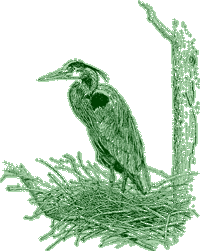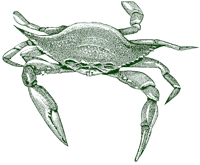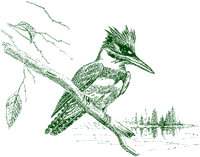Subject Areas
Science, Art, Language Arts
Duration
One or two class periods
Setting
Classroom
Skills
 Interpretation, identifying, describing, applying Interpretation, identifying, describing, applying
Charting the Course
The myriad of species that inhabit the region called Down Jersey are an integral part of the continued connections between people and place. This activity examines only one of the ecosystems and habitats that can be found here. This activity is presented as a model and means to stimulate other creative ways to decorate the classroom to expand the students’ knowledge of the many orgnaisms and their interactions from within the environment.
Vocabulary
Species, organism, ecosystem, habitat, food web, food pyramid*
* others as identified by the teacher with extensions or variations of the activity
Correlation to NJ Core Curriculum Content Standards
Science: 5.1 (1,2,3), 5.6 (3,6), 5.7 (1,2,4)
Language Arts: 3.2 (1,7), 3.5 (1,2,4,7)
Art: 1.2 (1,2,3), 1.3 (1,2) |
Objectives
Students will
- Utilize simple pen and ink drawings of a variety of Delaware Bay estuary animals to create a variety of display projects for the classroom and/or school building.
- Be able to identify some basic wildlife species that inhabit the estuary and bay.
Materials
Copies of the following pages in varying magnifications — a packet for each group of students, oaktag or poster board, scissors, glue, water color paints, markers, crayons, etc.
Optional: field guides of fish, invertebrates, birds, etc.
Making Connections
The myriad life forms that inhabit the Down Jersey region and the Delaware Bay estuary are an integral part of any investigation into the area. A significant part of the attraction and unique features of the area is directly related to the wildlife species that inhabit the saltmarsh and bay. This activity is well suited as an introduction to the animals, as a culminating activity following a field trip experience, as an awareness and identification activity. It also provides an opportunity for students to become familiar with utilizing field guides and field identification techniques.
Background
Utilize the field guides and other information contained in this packet to provide background information on the species included in this activity. Extensive background information on particular species could be obtained by individual students during a research component if initiated. The extent of involvement with researching individual species is left totally at the discretion of the teacher.
 Procedure Procedure
- Distribute the photocopied organisms. The number and size of the photocopies are dependent on the teacher’s desired project(s) choices. Some may need to be enlarged or reduced, and for some projects, multiple copies will be needed (i.e., for the food pyramid, many of the “primary consumers” are needed in relative comparison to the “secondaryconsumers”).
- Have the students work in small groups, giving each group the task of creating one of the suggested projects below utilizing the accompanying drawings or have students work individually to identify their organism, color it accurately. And create one large mural, bulletin board or display using all the students in a class. The choice is obviously up to each teacher and the grade level and abilities of their students. This would also make for an excellent “extra credit” project.
Notes from the author:
The pages to follow come from the New Jersey Marine Sciences Consortium (NJMSC), a not-for-profit organization dedicated to providing New Jersey’s citizens with an unbiased source of information about our marine and coastal resources. We accomplish our mission in a variety of ways including pre-college programs, professional development for educators, family science programs, undergraduate and graduate programs, public outreach initiatives and managed research. The NJMSC operates a field station on Sandy Hook, New Jersey, within the Gateway National Park there. For more information about the NJMSC and its programs please call (732)872-1300, ext. 22.
On the pages to follow you will find information about many species common to New Jersey’s marine and estuarine environments. Each picture is accompanied by the organism’s common and Latin name, information on what that organism eats and what the organism is eaten by. It is hoped that you will duplicate these sheets and use them frequently. These sheets have been used many times for many projects and purposes. Use a Xerox machine to copy, recopy and resize the pictures included in this packet. Mount the pictures on a heavier piece of paper, cut them out and lightly “wash” over them with diluted watercolor paint. The Education Program at the NJMSC has used these sheets to complete the following projects:
Project/Activity Choices
- A Bulletin Board to familiarize students with our local, common species. This spring a board displayed the common organisms with individual plankters “raining” down. The headline on this bulletin board read, “Plankton Showers bring Summer Flounders.”
- A Bulletin Board depicting the marine food pyramid. Duplicate plankton and zooplankton many times to create the base of the pyramid. Mid-level predators include crabs, small fish (silversides, mummichogs) and mollusks. Top level predators include birds, larger fishes and humans.
- A Bulletin Board depicting the intricacies of the marine food web. Cut apart and using yarn or string, connect organisms according to who eats whom.
 A Food Web Game. By cutting apart these sheets you can create a set of cards which can be passed out to students standing in a circle, who can then pass around a rope linking prey to predator. Don’t forget to start with the sun. In this manner you can go up and down food chains many times, creating an intricate and interdependent web. A Food Web Game. By cutting apart these sheets you can create a set of cards which can be passed out to students standing in a circle, who can then pass around a rope linking prey to predator. Don’t forget to start with the sun. In this manner you can go up and down food chains many times, creating an intricate and interdependent web.
- A Bulletin Board or graph depicting species abundance on a seasonal basis. If you collect data yourself though seining or have access to similar data, an interesting graph can be created. At the NJMSC we collect data year-round with good frequency and we’d be happy to supply data to interested teachers.
- We’re sure you will have many additional great ideas. Teachers are without a doubt the most creative and resourceful people on earth! Enjoy.
4. Depending on the teacher’s preference, students should work either in small groups or independently to determine the most realistic coloration of each organism.
Assessment
Option 1
If students were each assigned an organism, the assessment could be a written report about that species’ life cycle, natural history, abundance and place in the food chain.
Option 2
If students worked together as a class to create one large mural and/or bulletin board, each student could be assigned to write a description of the topic/theme depicted (i.e., the food pyramid, the food web, etc.)
Extensions
This activity, although specifically addressing the estuary ecosystem, could easily be adapted to any other ecosystem within the Down Jersey region. Pen and ink drawings of indicative species would need to be obtained by the teacher. Other ecosystems (habitats) include, but are not limited to: freshwater stream or river, freshwater marsh, woodland, cedar swamp, hardwood forest, Pinelands, bog, a suburban lot, etc. In addition, Project/Activity Choices are those of the author. We would encourage other ideas that may be spurred by this activity. The possibilities are endless!
Please download the PDF for the complete Lesson Plan.
| Resources
The Biology of the Hudson-Raritan Estuary — A Teacher’s Guide
Copyright 1998, Education Program staff, NJ Marine Sciences Consortium, Building 22, Fort Hancock, NJ 07732.
Bridges to the Natural World
Copyright 1992, New Jersey Audubon Society, 790 Ewing Avenue, PO Box 125, Franklin Lakes, New Jersey 07417-2271. Permission needs to be granted for use of artwork which is copyrighted by Carol Decker.
Any of the graphics contained in this guide may be used for a similar activity.
Any of the number of field guide series may be used for identification and realistic coloring of the organisms. |
|


 Interpretation, identifying, describing, applying
Interpretation, identifying, describing, applying  Procedure
Procedure A Food Web Game. By cutting apart these sheets you can create a set of cards which can be passed out to students standing in a circle, who can then pass around a rope linking prey to predator. Don’t forget to start with the sun. In this manner you can go up and down food chains many times, creating an intricate and interdependent web.
A Food Web Game. By cutting apart these sheets you can create a set of cards which can be passed out to students standing in a circle, who can then pass around a rope linking prey to predator. Don’t forget to start with the sun. In this manner you can go up and down food chains many times, creating an intricate and interdependent web.